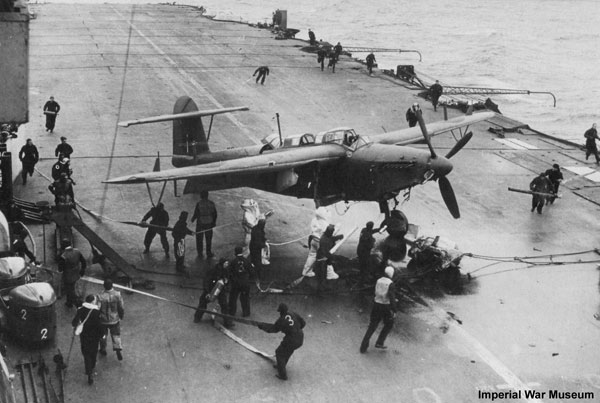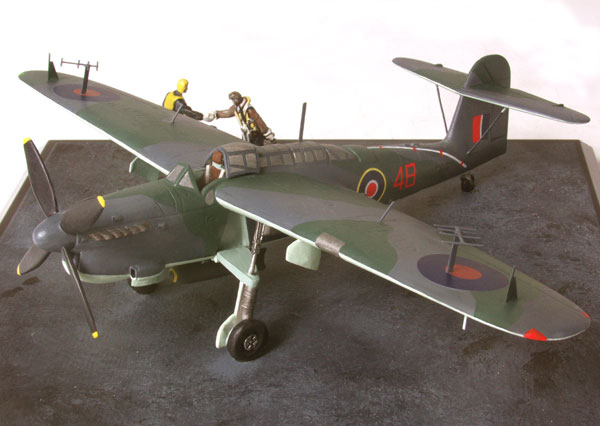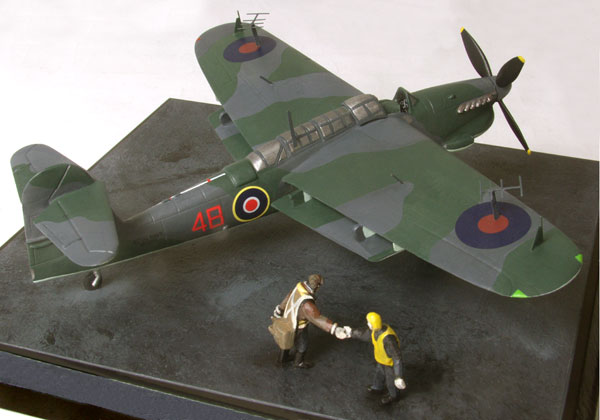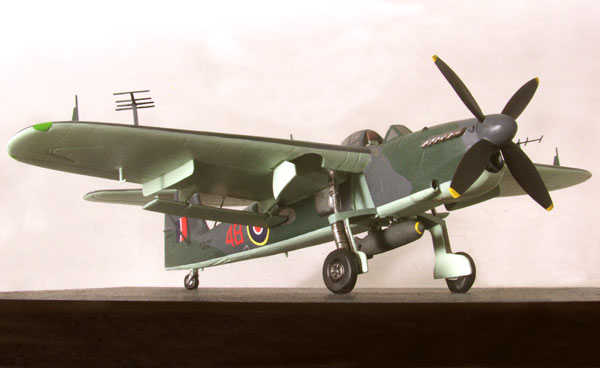Fairey Barracuda Mk II
Fairey Barracuda Mk II MD690 4B
HMS Formidable, Operation Goodwood III, 24th August 1944.
The specification that led to the Barracuda was one of the first to be issued following the transfer of the Fleet Air Arm to full Royal Navy control; having ordered the Swordfish and its successor the Albacore to a Torpedo-Spotter-Reconnaissance requirement the Admiralty required a Torpedo-Bomber-Reconnaissance monoplane, and following negotiations with the Air Ministry Specification S.24/37 was issued to industry at the beginning of 1938. Eight designs were submitted by seven companies, those from Fairey Aviation and Supermarine being approved for prototype construction, though the latter’s Type 322, which had the novelty of a variable incidence wing, did not progress beyond the prototype stage.
The Fairey Type 100 was designed around the 24-cylinder Rolls-Royce Boreas, but this engine’s development was stopped and it was replaced by a Merlin 30 of 1,300 hp. and with this powerplant prototype P1767 made its first flight on 7 December 1940. Its appearance differed from that of the very recognisable production Barracudas in having the tailplane at the junction of the fin and the fuselage; in development this was raised about three-quarters of the way up the fin because of turbulence caused by the large Fairey-Youngman flaps, these being virtually separate aerofoils set below and behind the trailing edge inboard of the ailerons. They played a part in ensuring the type’s dive-bombing performance, a role in which it served increasingly through its wartime career. Another visual feature was its wide-track undercarriage that retracted in to both fuselage and wing and which looked as though it owed something to civil engineering practice. The main production Barracuda was the Mk.II with the Merlin 32 of 1,640 hp. of which over 1,600 were built; as well as Fairey, Blackburn, Boulton Paul and Westland produced this mark. The Mk.III was intended for anti-submarine reconnaissance and carried ASV radar in a radome under the rear fuselage, with over 800 coming from Fairey and Boulton Paul. The final production model, the Mk.V, had a Griffon engine and a larger vertical tail.
The Barracuda II entered front line service with 827 Naval Air Squadron in January 1943, replacing its Albacores, and by the end of that year ten further squadrons had been commissioned, flying from both fleet and light carriers organised as TBR (Torpedo Bomber Reconnaissance) Wings. Most of their activity in Europe was in Norwegian waters, the best known being a series of operations against the German battleship Tirpitz. Moored in a Norwegian fjord, and even when under repair in the spring of 1944 after attacks by midget submarines, the ship presented a constant potential threat to the Royal Navy’s Home Fleet and to the shipping it protected, and three series of attacks were carried out by the Fleet Air arm; Operation Tungsten was mounted in April, Mascot in July and Goodwood in August.
Blackburn-built MD690 was one of thirty-three Barracudas launched on 24 August for Goodwood III, the heaviest raid mounted by the FAA; they were accompanied by ten Hellcats, twenty-four Corsairs and ten Fireflies, with the Hellcats and some of the Corsairs also carrying bombs. The standard weapon for the Barracudas was a 1,600 lb armour-piercing bomb, and while one of these scored a direct hit on the Tirpitz just forward of the bridge penetrating the armoured deck, it failed to explode. A fourth Goodwood was mounted five days later, but with no conclusive damage, and the ship’s fate was finally sealed in November by No.617 Squadron RAF and the “Tallboy” bomb.
The Barracuda continued its operational career in the Pacific, and continued in service with the Fleet Air Arm, generally in second-line roles, until 1953. In 1948 ten were supplied to France and continued in use until 1956, reputedly on clandestine reconnaissance and intelligence-gathering missions. No complete Barracuda survives, with only a nose on display in the Fleet Air Arm Museum.

Scale 1:72 Wingspan 8.2″ (208 mm)
Base size 7.71″ (196 mm) square (No. 5)
Weight not including base 15 ozs (422 grams) Limited edition of 25 only
Price £110.00 plus delivery Figures optional at £15 each.




